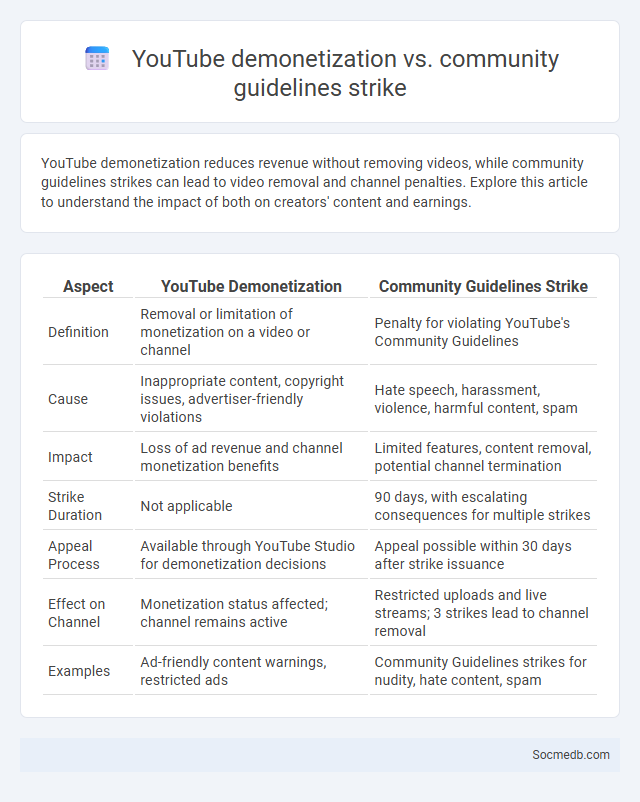
Photo illustration: YouTube demonetization vs community guidelines strike
YouTube demonetization reduces revenue without removing videos, while community guidelines strikes can lead to video removal and channel penalties. Explore this article to understand the impact of both on creators' content and earnings.
Table of Comparison
| Aspect | YouTube Demonetization | Community Guidelines Strike |
|---|---|---|
| Definition | Removal or limitation of monetization on a video or channel | Penalty for violating YouTube's Community Guidelines |
| Cause | Inappropriate content, copyright issues, advertiser-friendly violations | Hate speech, harassment, violence, harmful content, spam |
| Impact | Loss of ad revenue and channel monetization benefits | Limited features, content removal, potential channel termination |
| Strike Duration | Not applicable | 90 days, with escalating consequences for multiple strikes |
| Appeal Process | Available through YouTube Studio for demonetization decisions | Appeal possible within 30 days after strike issuance |
| Effect on Channel | Monetization status affected; channel remains active | Restricted uploads and live streams; 3 strikes lead to channel removal |
| Examples | Ad-friendly content warnings, restricted ads | Community Guidelines strikes for nudity, hate content, spam |
Understanding YouTube Demonetization
YouTube demonetization occurs when your videos fail to meet the platform's advertiser-friendly guidelines, resulting in reduced or removed ad revenue. Critical factors influencing demonetization include content involving violence, controversial topics, or copyrighted material, which can trigger automated or manual reviews. Understanding these criteria helps creators optimize their content strategy for sustained monetization and audience growth.
What Are Community Guidelines Strikes?
Community guidelines strikes are penalties imposed on social media users when they violate platform rules designed to maintain safe and respectful interactions. These strikes can result in temporary restrictions, content removal, or even account suspension depending on the severity and frequency of the violations. Platforms like YouTube, Instagram, and Facebook use strikes to enforce policies against hate speech, misinformation, harassment, and other prohibited content.
Key Differences: Demonetization vs Community Guidelines Strike
Social media platforms enforce demonetization by restricting monetization features on your content, primarily affecting creators' earnings, whereas community guidelines strikes directly penalize violations by limiting account functionality or leading to suspension. Demonetization usually results from content deemed unsuitable for advertisers, while community guidelines strikes address breaches such as hate speech, harassment, or misinformation. Understanding these distinctions helps you navigate platform policies and maintain account health effectively.
Common Reasons for YouTube Demonetization
YouTube demonetization often occurs due to violations of community guidelines, copyright infringements, and failure to meet advertiser-friendly content standards. Content containing inappropriate language, violent or harmful behavior, and misinformation frequently triggers automated demonetization algorithms. To maintain monetization, You must ensure your videos comply with YouTube's policies and consistently produce original, advertiser-approved material.
How Community Guidelines Strikes Affect Your Channel
Strikes on social media community guidelines can significantly impact your channel's visibility and content distribution, often leading to temporary restrictions or permanent bans. Accumulating multiple strikes may result in limited access to monetization features and reduced audience engagement. Maintaining adherence to platform rules is essential to safeguard your channel's growth and reputation.
Impact of Demonetization on Content Creators
Demonetization significantly disrupted content creators' revenue streams, forcing many to seek alternative income sources such as brand deals and crowdfunding. Your ability to adapt quickly by diversifying monetization methods determines long-term sustainability in a volatile digital economy. Platforms' shifting policies often challenge creators to maintain engagement while balancing monetization restrictions.
Steps to Resolve Demonetization Issues
To resolve demonetization issues on social media platforms, first identify the specific policy violations triggering the action by reviewing detailed platform guidelines from sources like YouTube or Facebook. Next, submit a well-documented appeal or request for review, providing clear evidence that your content complies with community standards and advertiser-friendly policies. Continuously monitor account status and analytics to detect further restrictions early and adjust content strategy accordingly to maintain monetization eligibility.
How to Avoid Community Guidelines Strikes
To avoid community guidelines strikes on social media, consistently review and adhere to each platform's content policies, paying particular attention to prohibited content such as hate speech, misinformation, and copyright infringement. Utilize privacy settings and moderation tools to control user interactions and remove inappropriate comments or posts promptly. Regularly update your knowledge of platform guidelines since these policies evolve frequently, minimizing the risk of accidental violations that could lead to strikes or account suspension.
YouTube Appeals Process: Strikes and Demonetization
YouTube's appeals process allows creators to challenge strikes or demonetization decisions that impact their channel's visibility and revenue. By submitting a detailed appeal, You can request a thorough review if you believe content was mistakenly penalized under YouTube's Community Guidelines or AdSense policies. Understanding the criteria for strikes and demonetization helps YouTube creators maintain compliance and protect their monetization status.
Best Practices for Maintaining Monetization and Compliance
Maintaining monetization on social media requires strict adherence to platform policies and consistent content quality that aligns with community guidelines. Utilizing data analytics helps optimize engagement while ensuring all advertisements comply with FTC regulations to avoid penalties. Regularly updating knowledge on the latest platform algorithm changes and copyright laws enhances sustainable revenue streams and user trust.
 socmedb.com
socmedb.com